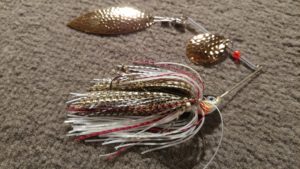How to Make Soft Plastic Swimbaits
 If you fish with swimbaits, you should learn how to make soft plastic swimbaits yourself.
If you fish with swimbaits, you should learn how to make soft plastic swimbaits yourself.
As with making any kind of lure yourself, if you learn how to make your own soft plastic swimbaits, it will save you money and give you the opportunity to make baits that are exactly what you want. You will no longer be limited to what’s available from retailers.
Additionally, you will be able to custom create colors that you can’t buy. This comes in handy when you want to “match the hatch” on a specific lake and, and duplicate the look of a certain type of baitfish. Many times this will trigger bites that you would not otherwise be able to get.
Many people begin pouring their own soft plastic lures as a hobby, but it quickly becomes an obsession! It can be addictive once you get started 🙂
For today, we’re going to focus on how to make soft plastic swimbaits, so let’s get back to that topic!
The video below is a great tutorial, showing just about everything you’ll need to know to make these baits successfully.
The video creator is using the 3.5 inch Ripper swimbait mold, which is part of the Do-It Essentials Mold series. This is a great mold. It’s high quality, and it just plain works!
When you click that link above, scroll down to find the 3.5 inch Ripper swimbait (Model 014). It’s an awesome swimbait that flat out catches fish.
Unlike the mold used by the video creator, the mold we linked to above is a 3-cavity mold, which will speed things up considerably when it comes to pouring larger numbers of swimbaits in a short time.
Also, below the video we have listed all of the items you’ll need to pour your own soft plastics, including some of the basic equipment and safety equipment as well.
As with anything, be sure to wear the necessary safety gear, to prevent getting burned or breathing in large amounts of fumes when pouring soft plastic baits. Safety always comes first!
So, now that we’ve got all of that out of the way, give the video below a watch and be sure to take note for later. We promise that you will want to do this after watching!
Items used for this project:
- Do-It Essential Series Molds
- Essential Series Starter Kit
- Essential Series Plastisol
- 4 oz. Medium Hand Injector
- Soft Plastic Liquid Color
- Scented Worm Oil
- Poly Glitter
- Hot Mill Gloves
- Pyrex Pouring Cups
If you enjoyed this post, please be sure to like it and share it with your friends.
If you’d like to learn how to tie your own bucktail jigs, click here.
And, as always, if you need any kind of lure-making supplies, be sure to visit our website, at http://lurepartsonline.com

 How to Pour Lead Head Jigs
How to Pour Lead Head Jigs Now that the jig head is poured and the paint is cured, it’s time to put the eyes on!
Now that the jig head is poured and the paint is cured, it’s time to put the eyes on! If you’re a hardcore Musky angler, you will undoubtedly want to learn How To Build a Double Cowgirl Musky Inline Spinner.
If you’re a hardcore Musky angler, you will undoubtedly want to learn How To Build a Double Cowgirl Musky Inline Spinner.
